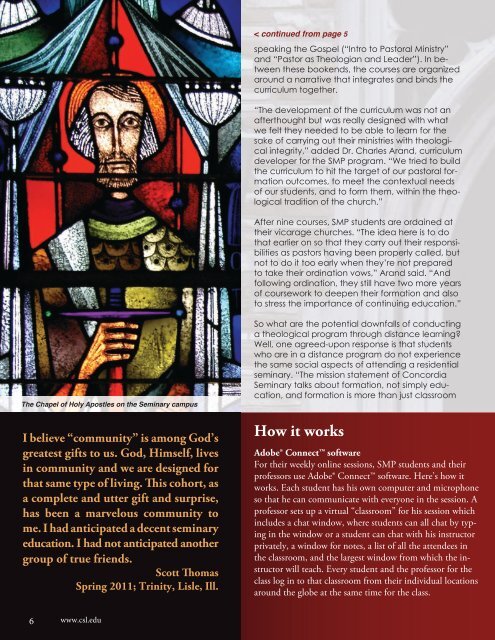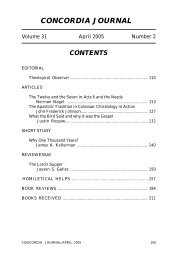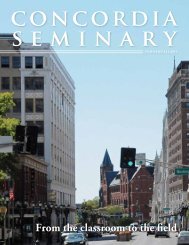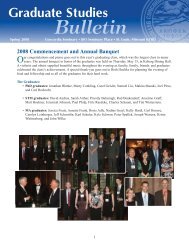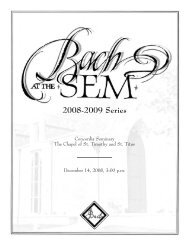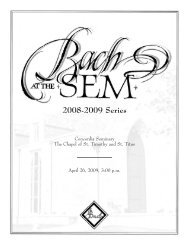Concordia Seminary magazine | Winter 2012
Concordia Seminary magazine | Winter 2012
Concordia Seminary magazine | Winter 2012
You also want an ePaper? Increase the reach of your titles
YUMPU automatically turns print PDFs into web optimized ePapers that Google loves.
The Chapel of Holy Apostles on the <strong>Seminary</strong> campus<br />
I believe “community” is among God’s<br />
greatest gifts to us. God, Himself, lives<br />
in community and we are designed for<br />
that same type of living. This cohort, as<br />
a complete and utter gift and surprise,<br />
has been a marvelous community to<br />
me. I had anticipated a decent seminary<br />
education. I had not anticipated another<br />
group of true friends.<br />
Scott Thomas<br />
Spring 2011; Trinity, Lisle, Ill.<br />
6<br />
www.csl.edu<br />
< continued from page 5<br />
speaking the Gospel (“Intro to Pastoral Ministry”<br />
and “Pastor as Theologian and Leader”). In between<br />
these bookends, the courses are organized<br />
around a narrative that integrates and binds the<br />
curriculum together.<br />
“The development of the curriculum was not an<br />
afterthought but was really designed with what<br />
we felt they needed to be able to learn for the<br />
sake of carrying out their ministries with theological<br />
integrity,” added Dr. Charles Arand, curriculum<br />
developer for the SMP program. “We tried to build<br />
the curriculum to hit the target of our pastoral formation<br />
outcomes, to meet the contextual needs<br />
of our students, and to form them, within the theological<br />
tradition of the church.”<br />
After nine courses, SMP students are ordained at<br />
their vicarage churches. “The idea here is to do<br />
that earlier on so that they carry out their responsibilities<br />
as pastors having been properly called, but<br />
not to do it too early when they’re not prepared<br />
to take their ordination vows,” Arand said. “And<br />
following ordination, they still have two more years<br />
of coursework to deepen their formation and also<br />
to stress the importance of continuing education.”<br />
So what are the potential downfalls of conducting<br />
a theological program through distance learning?<br />
Well, one agreed-upon response is that students<br />
who are in a distance program do not experience<br />
the same social aspects of attending a residential<br />
seminary. “The mission statement of <strong>Concordia</strong><br />
<strong>Seminary</strong> talks about formation, not simply education,<br />
and formation is more than just classroom<br />
How it works<br />
Adobe® Connect software<br />
For their weekly online sessions, SMP students and their<br />
professors use Adobe® Connect software. Here’s how it<br />
works. Each student has his own computer and microphone<br />
so that he can communicate with everyone in the session. A<br />
professor sets up a virtual “classroom” for his session which<br />
includes a chat window, where students can all chat by typing<br />
in the window or a student can chat with his instructor<br />
privately, a window for notes, a list of all the attendees in<br />
the classroom, and the largest window from which the instructor<br />
will teach. Every student and the professor for the<br />
class log in to that classroom from their individual locations<br />
around the globe at the same time for the class.


